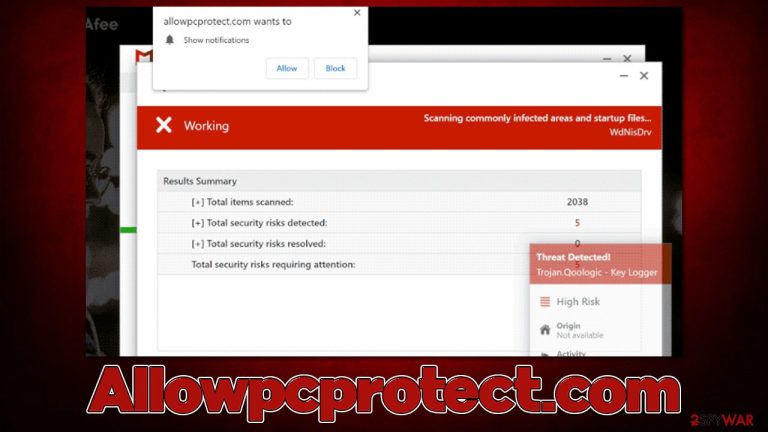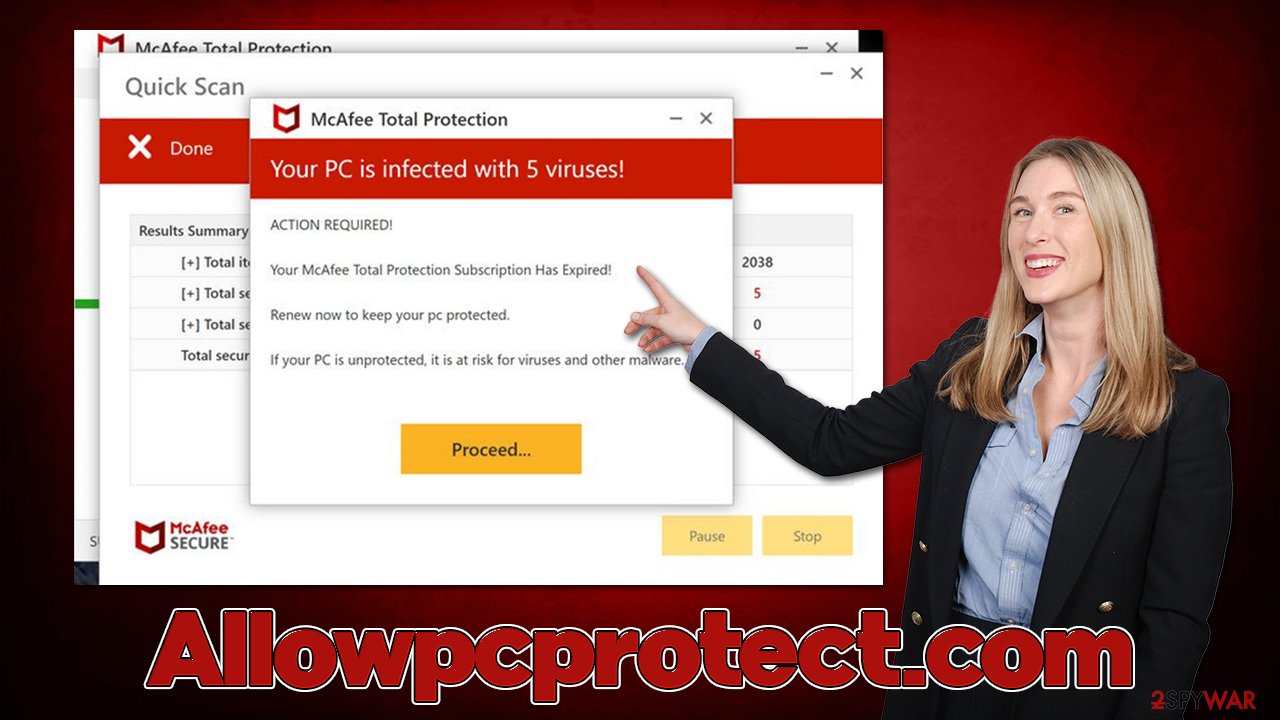Allowpcprotect.com ads (Tutorial) - Chrome, Firefox, IE, Edge
Allowpcprotect.com ads Removal Guide
What is Allowpcprotect.com ads?
Allowpcprotect.com shows fake security alerts to make users download potentially malicious software

Allowpcprotect.com is a scam website that specializes in misleading messages about users' computer health in order to make them purchase fake security software. In addition, visitors are asked to enable push notifications so that intrusive advertisements can be shown to them later on top of all the other running apps.
In most cases, users encounter this website when they are browsing pages of dubious nature, e.g., torrents or illegal video streaming sites, which are full of booby-trapped links and fake “Download” buttons, which, once clicked, would take people to a malicious website. Alternatively, those infected with adware[1] or other malware might start receiving frequent Allowpcprotect.com redirects.
In this article, we will show how to remove the annoying push notifications, check the system for infections effectively, and how to deal with the potential consequences of interaction with scam link clicks, data disclosure, and potentially malicious download files.
| Name | Allowpcprotect.com |
| Type | Scam, ads, redirect |
| Infiltration | Compromised websites, pop-up ads, potentially unwanted applications |
| Scam content | Claims that the subscription for security software has expired and that it needs to be renewed immediately. Asks to download malicious software and enable push notifications |
| Dangers | Installation of PUPs or malware, sensitive information disclosure, monetary losses |
| Removal | You should not interact with the contents shown by a scam website and instead, check your system for adware or malware infections with SpyHunter 5Combo Cleaner security software |
| Remediation | Third-parties can employ cookies to continue tracking your online activities, so we recommended clearing browser caches and other leftover PUP files with FortectIntego |
More about the scam
Social engineering is a type of scam technique that is commonly used to mislead users and make them perform actions they would not under normal circumstances. Crooks can present certain elements as those that are familiar to users, which provides a fake impression of trustworthiness. In this case, the authors of the Allowpcprotect.com scam rely on popular security software vendors such as Norton or McAfee.
Upon website entry, visitors are presented with what seems like a scan performed by anti-malware software. The website is programmed to look almost identical to the official security software scan process. However, the pop-up windows are completely fabricated, and the scan process is just an imitation.
Once the alleged virus scan is complete, users are presented with fake results, which, unsurprisingly present several detections of Trojans and other high-risk threats. The message reads as follows:
Your PC is infected with 5 viruses!
ACTION REQUIRED
Your McAfee Subscription Has Expired!
Renew now to keep your PC protected.
If your PC is unprotected, it is at risk for viruses and other malware.
The truth is, that third parties can't detect what is installed (or not) on your system. They might be able to identify your IP address, operating system, or the browser you are using – these are all general details that can be read. The only way to identify whether or not your system is infected is by having a legitimate anti-malware installed, for example, Malwarebytes or SpyHunter 5Combo Cleaner.

Using fearmongering is something that is quite common, and Allowpcprotect.com is not the only website doing this. We have recently detected websites like Sikxsx.xyz, Protectconnection.icu, or Playsuperrecentthefile.vip using similar techniques to intimidate users.
What to do now?
If you have encountered the fake Allowpcprotect.com scam message, you should not panic, as, most likely, there are no viruses on your computer. Naturally, we recommend performing a full system scan with powerful security software just to be safe – it could also remove the most aggressive adware that could be the cause of unwanted browser redirects.
If security software did not find anything, we recommend checking other sections of your system for unwanted software. First of all, let's look at what's installed on the browser as extensions – you can find them vie the special “Extensions” button next to the “Settings” button, next to the URL bar. Note that even some trustworthy extensions might sometimes go rogue, so if you still encounter ads and other issues, we recommend you remove everything and reinstate apps one by one.
The next step is to check whether something is installed on the system level – here's how (if you aren't sure what's meant to be installed on your device, please skip this step):
Windows
- Enter Control Panel into Windows search box and hit Enter or click on the search result.
- Under Programs, select Uninstall a program.

- From the list, find the entry of the suspicious program.
- Right-click on the application and select Uninstall.
- If User Account Control shows up, click Yes.
- Wait till uninstallation process is complete and click OK.

Mac
While moving apps into Trash is how you delete most normal applications, adware tends to create additional files for persistence. Thus, you should look for .plist and other files that could be related to the virus. If you are not sure, skip this step entirely.
- From the menu bar, select Go > Applications.
- In the Applications folder, look for all related entries.
- Click on the app and drag it to Trash (or right-click and pick Move to Trash)

To fully remove an unwanted app, you need to access Application Support, LaunchAgents, and LaunchDaemons folders and delete relevant files:
- Select Go > Go to Folder.
- Enter /Library/Application Support and click Go or press Enter.
- In the Application Support folder, look for any dubious entries and then delete them.
- Now enter /Library/LaunchAgents and /Library/LaunchDaemons folders the same way and terminate all the related .plist files.
Your final step is making sure that your browsers are clean from cookies[2] and other trackers to prevent third-party tracking. When you visit websites and enter your passwords or other login details, these preferences are saved in the form of cookies. These can sometimes be hijacked[3] by malicious parties, so clearing them regularly can reduce the chance of encountering this dangerous problem. For that, either use FortectIntego or proceed with the instructions below:
Google Chrome
- Click the Menu and pick Settings.
- Under Privacy and security, select Clear browsing data.
- Select Browsing history, Cookies and other site data, as well as Cached images and files.
- Click Clear data.

Mozilla Firefox
- Click Menu and pick Options.
- Go to Privacy & Security section.
- Scroll down to locate Cookies and Site Data.
- Click on Clear Data…
- Select Cookies and Site Data, as well as Cached Web Content and press Clear.

MS Edge (Chromium)
- Click on Menu and go to Settings.
- Select Privacy and services.
- Under Clear browsing data, pick Choose what to clear.
- Under Time range, pick All time.
- Select Clear now.

Safari
- Click Safari > Clear History…
- From the drop-down menu under Clear, pick all history.
- Confirm with Clear History.

Also, if you have enabled notifications from Allowpcprotect.com and now annoying pop-up ads are showing up on your screen at random times, you should access browser settings and deny the access. Proceed with the following:
Google Chrome
- Open Google Chrome browser and go to Menu > Settings.
- Scroll down and click on Advanced.
- Locate the Privacy and security section and pick Site Settings > Notifications.
- Look at the Allow section and look for a suspicious URL.
- Click the three vertical dots next to it and pick Block. This should remove unwanted notifications from Google Chrome.

Mozilla Firefox
- Open Mozilla Firefox and go to Menu > Options.
- Click on Privacy & Security section.
- Under Permissions, you should be able to see Notifications. Click the Settings button next to it.
- In the Settings – Notification Permissions window, click on the drop-down menu by the URL in question.
- Select Block and then click on Save Changes. This should remove unwanted notifications from Mozilla Firefox.

MS Edge (Chromium):
- Open Microsoft Edge, and go to Settings.
- Select Site permissions.
- Go to Notifications on the right.
- Under Allow, you will find the unwanted entry.
- Click on More actions and select Block.

Safari:
- Click on Safari > Preferences…
- Go to the Websites tab and, under General, select Notifications.
- Select the web address in question, click the drop-down menu and select Deny.

Note: within the settings, you can enable the “Use quieter notifications” option, which would make the annoying notification prompt much less intrusive overall. You can still view it by clicking a small prompt button on the left side of the address bar and then accepting notifications from the website. Choosing “Don't allow sites to send notifications” would stop showing them completely on all websites.
How to prevent from getting adware
Choose a proper web browser and improve your safety with a VPN tool
Online spying has got momentum in recent years and people are getting more and more interested in how to protect their privacy online. One of the basic means to add a layer of security – choose the most private and secure web browser. Although web browsers can't grant full privacy protection and security, some of them are much better at sandboxing, HTTPS upgrading, active content blocking, tracking blocking, phishing protection, and similar privacy-oriented features. However, if you want true anonymity, we suggest you employ a powerful Private Internet Access VPN – it can encrypt all the traffic that comes and goes out of your computer, preventing tracking completely.
Lost your files? Use data recovery software
While some files located on any computer are replaceable or useless, others can be extremely valuable. Family photos, work documents, school projects – these are types of files that we don't want to lose. Unfortunately, there are many ways how unexpected data loss can occur: power cuts, Blue Screen of Death errors, hardware failures, crypto-malware attack, or even accidental deletion.
To ensure that all the files remain intact, you should prepare regular data backups. You can choose cloud-based or physical copies you could restore from later in case of a disaster. If your backups were lost as well or you never bothered to prepare any, Data Recovery Pro can be your only hope to retrieve your invaluable files.
- ^ Adware. Investopedia. Source of financial content on the web.
- ^ What are cookies? | Cookies definition. Cloudflare. The Web Performance & Security Company.
- ^ What is Session Hijacking and How Does it Work?. KeyFactor. PKI Consulting Experts.
